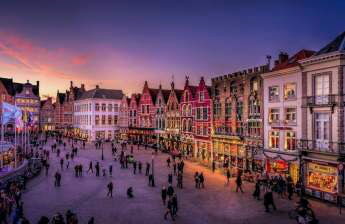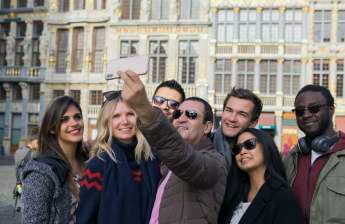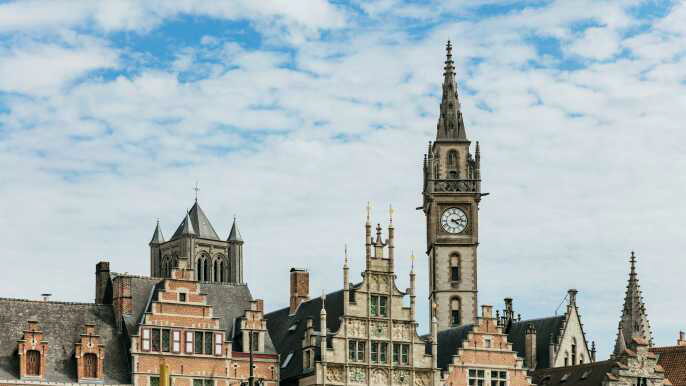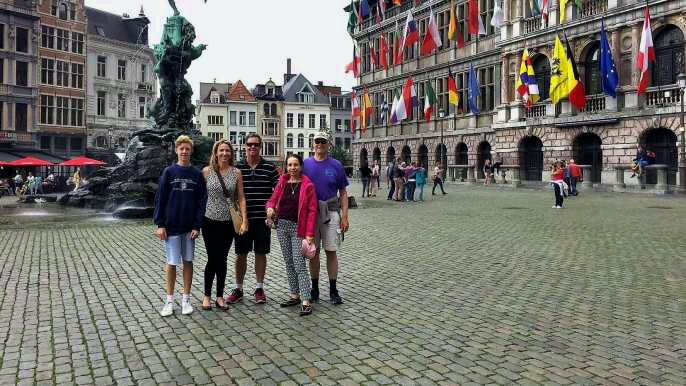Visiting Brussels may be a great idea if you are looking to see the main landmarks of the city. You may want to look at places like the Parc du Cinquantenaire and the La Monnaie Opera House. Or you may be interested in museums such as the Fashion and Lace Museum and the BELvue Museum.
Manneken Pis
Amongst the many famous landmarks in Brussels, one is the Manneken Pis. The statue is located in the city center. It is considered to be the mascot of Brussels and represents the quirky Belgian spirit. It has been around for over 400 years.
The first reference to the fountain is in administrative documents from 1451-1452. The word "manneken" comes from the Dutch language. In fact, the term is a cliche and has been used as a name for beer labels all over the world.
The original Manneken Pis was created in 1619 by the sculptor Jerome Duquesnoy the Elder. It is currently on display at the Museum of the City of Brussels in the Broodhuis.
The current sculpture is a copy of the original. It is said that the original statue was broken down into two pieces. However, only eleven of the originals were found.
The statue is dressed up in different costumes for different occasions. There are over 1000 different outfits in the collection. These costumes are given by leaders of the city of Brussels. These gifts are analyzed by the Friends of the Order of Manneken Pis and are delivered at an official ceremony.
La Monnaie Opera House
Located in the heart of Brussels, Royal Theatre La Monnaie is one of Europe's most beautiful opera houses. It has been performing operas for over 300 years. The opera house is considered a major cultural institution and a meeting place for arts and culture. The theatre has survived two world wars and has been a focal point of Brussels' history. It is a popular venue for music and ballet, and is also a renowned center for contemporary dance.
La Monnaie is known for its unique scale model of a baroque opera, and its reconstruction of 18th-century theater equipment. It also exhibits works by Giulio Paolini, David Claerbout, Sam Francis and Daniel Buren. The building is also an excellent example of European theatre architecture.
The theatre has been home to some of the most important artists of the 19th and early 20th centuries. The first permanent public theatre for opera performances was built here. The theatre's original auditorium was destroyed by fire in 1855, but it was rebuilt. It is now a symbol of the importance of the arts in Belgium and was renovated in 1999. It has a seating capacity of 1,152.
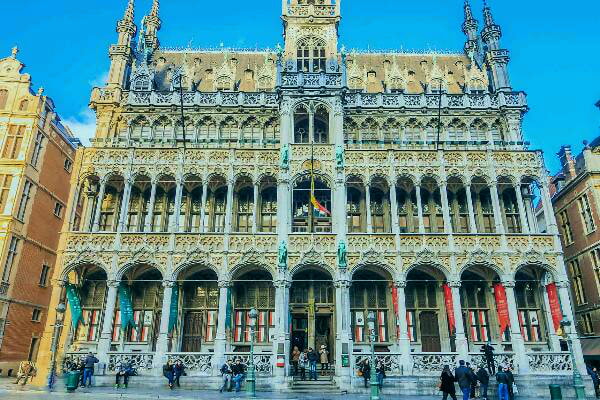
Notre Dame Du Sablon
Located in the Sablon district of Brussels, Notre Dame du Sablon is a famous gothic cathedral. The church is known for its architecture and its exterior sculptures. It has 11 beautiful stained glass windows.
The history of the cathedral begins in the 13th century. In that year, a local devout woman named Beatrijs Soetkens transported a statue of the Virgin Mary from Antwerp to Brussels. The statue was then venerated as a patron of the Crossbowmen's Guild. The guild promised to build a chapel on the site. The chapel was quickly transformed into a pilgrimage destination.
In the 15th century, the main altar was decorated with religious frescoes. The choir contains spandrels dating from the early 15th century. The Baroque pulpit was created by Marc de Vos. The pulpit is adorned with medallions of the Virgin Mary and Saint Thomas of Villanova.
A few years later, the church became a center of pilgrimage, with a statue of Christ carried in a procession around the church every year. The church also features dozens of medieval statuettes.
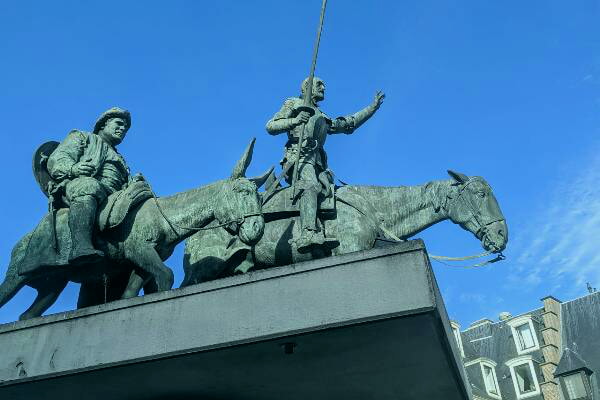
Fashion & Lace Museum
Located in Brussels, Belgium, the Fashion & Lace Museum presents collections of significant pieces of fashion history. The museum also houses textiles and accessories.
The Fashion & Lace Museum displays its collections through themed exhibitions and has an impressive exhibition hall. Visitors are offered a free guidebook and are given the opportunity to see the lace and other items up close.
The museum is housed in two 18th-century buildings. The main floor features a large exhibition hall, known as the Fashion Room. The exhibits are a mixture of old and new, including fine delicate lace, nineteenth-century crinolines, and historical wedding dresses.
The Fashion & Lace Museum has a special room dedicated to children's fashion. Kidorama uses fashion as a medium to tell a story about the development of individuality and the place a child belongs in the world. The exhibit will run from 8 July to 5 March 2023.
The museum has a large collection of lace, which includes lace from Bruges and Mechelen, as well as lace from all over the world. Some of the most elaborate lace requires hundreds of hours of weaving.
BELvue Museum
Located in Brussels, BELvue is a museum that focuses on the history of Belgium. It is a place where the past is brought to life through engaging multimedia displays and interactive exhibits. It also offers activities for people of all ages.
In addition to the permanent collection, BELvue hosts several special exhibitions. The museum features historical documents, artifacts, and audiovisual testimonials. Each room of the museum is dedicated to a different period in Belgium's history.
The BELvue Museum is located in a renovated 18th-century hotel. The hotel was originally used as a resting spot for dignitaries. It was later converted into a museum. It contains more than 200 exhibits.
Each room has an interactive display allowing visitors to see Belgium from a different point of view. In the museum, there are seven social themes that are addressed. These themes include prosperity, democracy, and migration.
In the past five years, more than 250,000 visitors have visited the BELvue Museum. The museum has also attracted thousands of young people. The main aim of the museum is to explain Belgian history to younger people and promote democratic values.
Parc du Cinquantenaire
Located in Brussels, Parc du Cinquantenaire, also known as the Julileepark, is one of the largest green urban areas in Brussels. It is the most beautiful park in the city, and it is home to a variety of museums and monuments.
The site was originally constructed in the 19th century to celebrate the golden jubilee of Belgian independence. Its design was originally designed by the Belgian architect Gedeon Bordiau, who envisioned two pavilions and a quadriga sculpture. However, construction was put on hold in 1890 due to lack of funding.
After the death of the original architect, Charles Girault was charged with renovating the central monument of the park. He revised the design to a triple arch. The structure measures 60 meters wide and 40 meters high, and the arch is made of blue stone. It features eight Belgian provinces, and a woman carrying a Belgian flag.
Parc du Cinquantenaire also contains the Royal Art and History Museums, which are located in the southern wing of the buildings. The museum showcases works of art, as well as the history of the Belgian economy.
Cantillon Brewery
Located on the fringe of Brussels' historic center, the Cantillon Brewery is a family-run facility specializing in spontaneously fermented lambic beers. It is one of the last traditional boutique breweries left in Brussels. This historic and working brewery is open for guided tours and holds open house events twice a year.
Cantillon is owned by the Van Roy-Cantillon family, who have been brewing beers for over a century. Jean Van Roy is the fourth-generation owner-brewer of the company.
Cantillon produces two main types of beer: Lambic and Gueuze. Cantillon uses wild yeast and ambient yeast for its lambics.
While the majority of Cantillon's beers are spontaneously fermented, some are brewed with hops. Hops are used to add flavor and bitterness. They also serve as a natural preservative. These types of beers are aged in oak barrels for one to three years.
Cantillon is also known for producing kriek, or fruited lambics, which are made with fresh fruit. The resulting beer is called framboise when raspberries are added.
Cantillon is also well-known for its experimental beers. These beers are sold in select pubs around the world. The flavors vary depending on the weather and the type of yeast that is present in the air.
Maison de la Bellone
Located in the bruxelloise heart of Brussels, the Maison de la Bellone (in English: House of the Bells) is a 17th-century aristocratic residence that underwent several restorations and reimaginings. The house was named in honor of the ancient Roman goddess of war, Bellona. The house is now an exhibition center.
The house is located on Flandre street, a short walk from the Place Sainte-Catherine. Its front door arch is topped with a statue of the ancient Roman goddess of war. The most important function of this opulent palace is to provide a forum for the various cultural institutions and organizations of the city. Its glass roof encases the inner courtyard. The house is a listed building, albeit not a visible one from the street. The city of Brussels purchased the house from a couple of unknowns in 1913. The house was restored in 1995.
The house was rechristened the "Maison de la Bellone" and is now protected by a glass roof. The house has several rooms that cater to different types of events. Among its attractions is an impressive baroque facade. The house is also the site of the Maison du Spectacle, a cleverly disguised information and support center for various cultural and cultural organizations.


